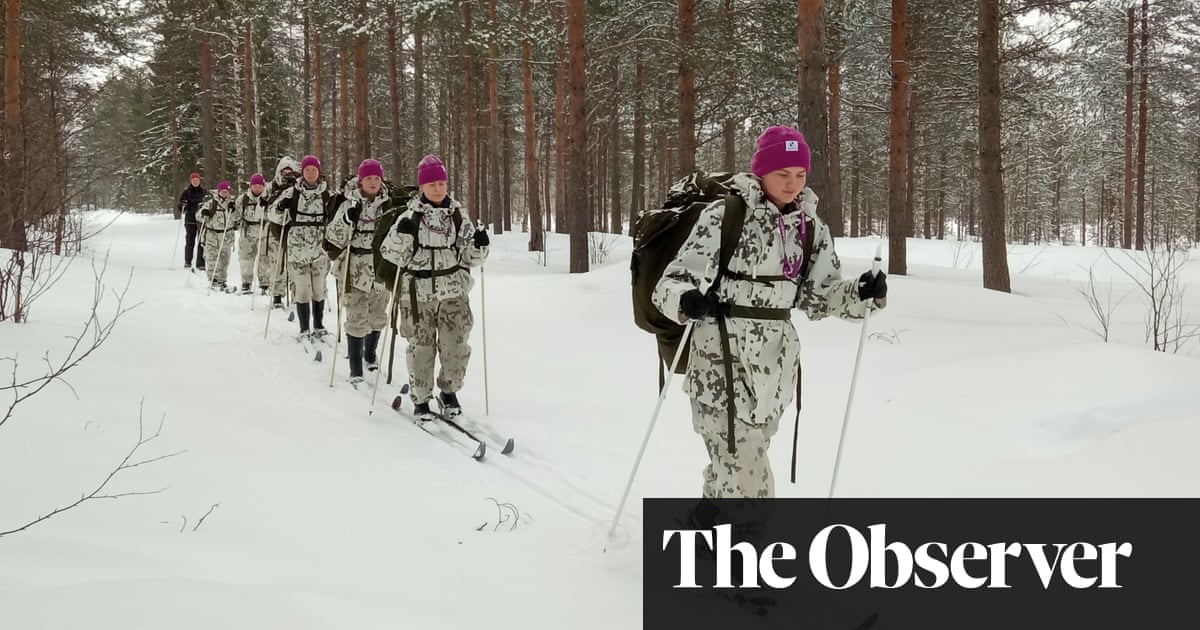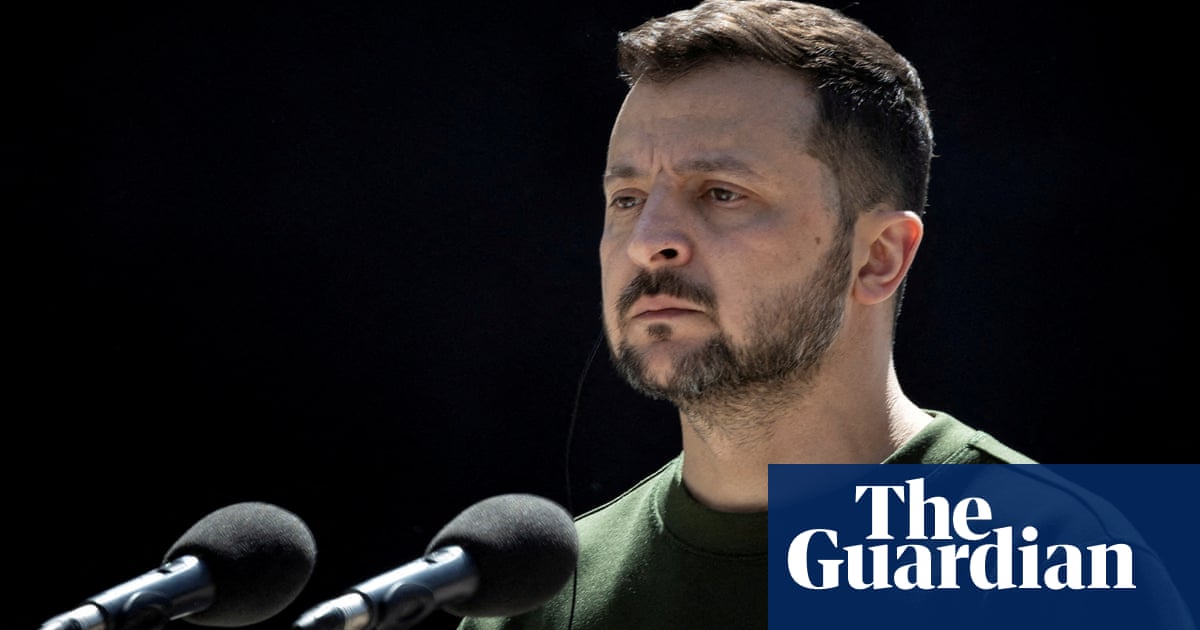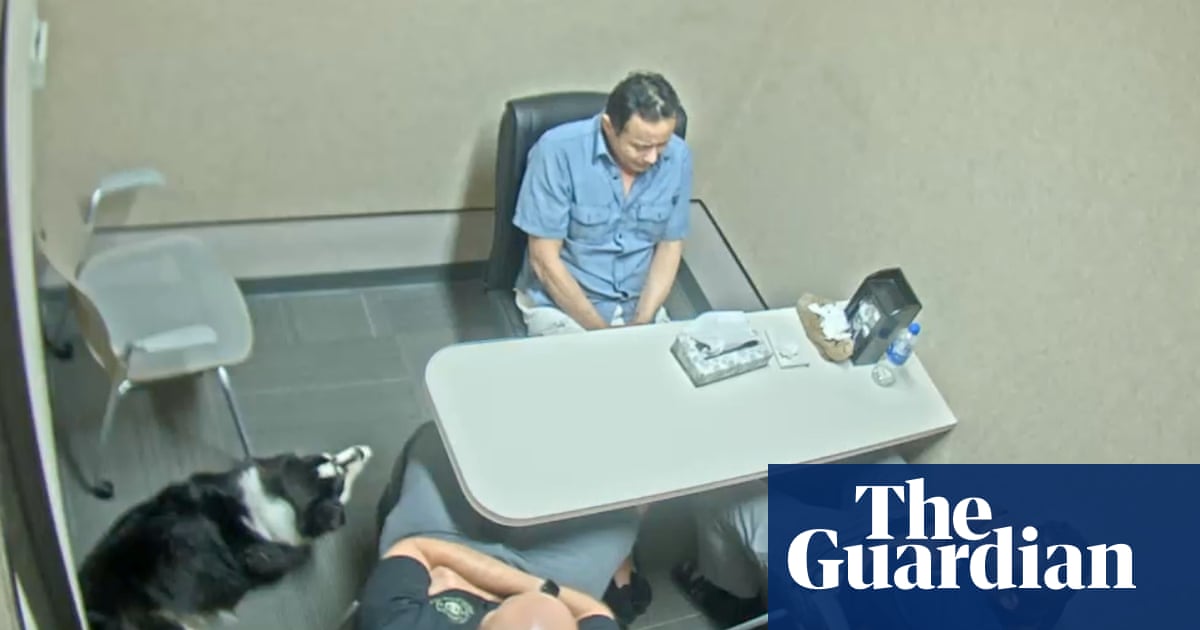It is Friday night on a forested military base in western Finland. A group of women dressed in camouflage with matching purple beanie hats are sat in a dark tent discussing how their perspectives have changed since Russia’s full-scale invasion of Ukraine.
“I didn’t think it was a real threat that Russia would attack us,” says Sari, 42, who works in sales and lives in a nearby town. But then, she adds: “They attacked Ukraine. I saw that it is possible that we are next.”
The mother of two, who describes herself as a “realist”, was moved to join this weekend-long “surviving without electricity” course by her patriotic values, but she also wants to be more prepared with practical skills for day-to-day life. She is one of about 75 women taking part.
While a power cut is a situation that could be brought on by a storm – as happened for tens of thousands across Finland last week – they are also skills that could prove crucial in a potential Russian invasion or hybrid attack.
The training course, known as Nasta, is one of 40 put on by the Women’s National Emergency Preparedness Association around Finland. Others include cybersecurity, mental resilience, wilderness skills, snowmobile driving and information influencing. After the invasion of Ukraine, applications for the courses soared. Not only does Finland have a history of war with its neighbour, but they also share a 830-mile land border.
Tytti, 36, has felt so anxious about relations with Finland’s hostile neighbour that she has been avoiding the news. Attending the course, she says, “is my way to confront my fears”.
Both women have been on one-day shooting courses in the last year or so, but do not like handling guns.
In the short term, Hannele, 67, is more afraid of the kind of hybrid warfare Finland is already experiencing, such as cyberwarfare and disinformation, than the prospect of imminent military combat. She is surprised by how many young women have been taking up arms. Still, she is curious to know: “How does it feel to shoot something?”
Until a few hours ago, most of the women, the youngest of whom is 18 and the oldest 70, did not know each other. But on this sub-zero snowy night in Lohtaja, near the town of Kokkola, they have already set up camp under a tall canopy of pines by torchlight, made a wood fire in a burner at the centre of the big military tent and made a plan for where everybody is going to sleep.
Throughout the weekend, the group will learn how to survive in a crisis – including how to build and put out fires, cook outside, deliver first aid, stay warm and build a toilet.
There is a rota for keeping the fire stoked overnight. Some of the group are using a big piece of tarpaulin to fix a leak in the tent.
While there is no official military interaction between the two neighbours, Finnish intelligence services describe Russia as Finland’s greatest national security threat and is in little doubt there is a hybrid war under way.
Last week, the Finnish foreign minister, Elina Valtonen, released a joint statement with her German counterpart expressing her “deep concern” about the suspected sabotage – one of two in the Baltic – of an undersea cable between Finland and Germany.
“The fact that such an incident immediately raises suspicions of intentional damage speaks volumes about the volatility of our times,” it said. Finland has since launched a joint investigation with Sweden, which, like Finland, has become a Nato member since the invasion of Ukraine.
Helsinki also accuses Russia of using proxies, including asylum seekers, to aggravate its neighbour; there have been suspicious break-ins at water treatment facilities and issues with GPS jamming.
Nasta has been running since 1997. Although its training is non-military, it is part-funded by the Finnish Ministry of Defence and receives substantial support from Finland’s National Defence Training Association. It has a membership of approximately 100,000. In the aftermath of Russia’s invasion on 24 February 2022, interest surged to unprecedented levels.
There were so many people queueing for a place on the courses that the system collapsed, says Suvi Aksela, Nasta’s communications and organisation manager, who compares getting a place on one of the subsidised courses to getting in-demand concert tickets. “Sometimes the courses are full within one minute.”
In the days after the invasion, the phone calls “just kept coming and coming and coming”, she says. The first question was often “what can I do?” And the second was “where can I learn how to shoot?” The third, she adds, was “how I can I find out about my bunker?” A recent inventory by the interior ministry found that Finland has 50,500 bunkers for its population of 5.6 million – part of the legacy of a Soviet Union attempt to invade the country during the second world war.
“The shooting bit kind of surprised me,” says Aksela. “Because we have our military personnel – the soldiers, the professionals – then we have a huge amount of reservists. If I am the one that has to pick up the gun, then we’re in deep trouble.”
The popularity of shooting in Finland has soared in the last two years. Earlier this year, the government announced a plan to open more than 300 new shooting ranges to encourage people to take it up as a hobby to bolster national defence. The number of Finns applying for gun licences has also risen significantly.
after newsletter promotion
Aksela advises callers to start with their at-home contingencies. Finnish households are encouraged to have enough supplies to survive unaided for at least 72 hours – food, water, medicine and access to a battery-powered radio – in case of an emergency.
The courses are most popular among university educated middle-aged women from the Helsinki area, says Aksela. As well as Russia’s close proximity to Finland, the collective memory of fighting the Soviet Union during the second world war also plays a significant role in informing the seriousness with which the perceived threat from Russia is taken by the Finnish public.
“It’s because of our history. It’s because of, obviously, our location. The neighbour isn’t very friendly, hasn’t been – even before [2022]. So we’re just very aware of the risks. A lot of countries let go of their conscription, Finland never did. So for us it’s common sense,” says Aksela.
The obligation to contribute to national defence is part of the Finnish constitution and all men are required to undertake military service (women can apply but on a voluntary basis).
The Finnish intelligence and security service, Supo, has warned that Russia treats Finland as an unfriendly state and as a target for espionage and “malign influence activities”.
The Supo deputy director, Teemu Turunen, said hybrid war is coming in multiple forms, including via proxies, cyberattacks, threat to critical infrastructure, disinformation and espionage. Russia, he said, is using asylum seekers as “tools for their own purposes” by inadequately guarding the Russian-Finnish border, which is why the eastern border remains closed and has been for most of the last year.
“The modus operandi of Russian intelligence services is more aggressive, it’s a more serious threat and they are using other means,” he said, including a threat to critical infrastructure and sabotage.
He added: “It’s very clear that this is the number one threat to Finnish national security: Russian state actors. And even blurring the lines between using proxy criminal organisations or other types of proxies.”
But, he said, it is important not to assume Russia is behind every potential incident. “It’s important to understand that Russia is not omnipotent. They are trying to exaggerate their capabilities.” Russia has more urgent priorities than Finland, he added, such as its own stability and the war in Ukraine. “So it is not that Russia could do anything, anywhere, anytime. They try to make us fear that, but it’s not the case.”
Asked how the election of Donald Trump affects Finland’s security and preparedness, he warned “the threat from the Russian side is not going away” and that as the US increasingly turns its focus to China, Europe must “step up and improve preparedness”.
Finns, he said, are “quite cool-headed about the threat”, but preparedness is at the heart of that. “Intelligent preparedness as well as societal resilience. It’s all part of the whole-of-society approach that Finland has and we have had for a long time already.”
But at the Nasta course, many have been activated by more recent events.
Walking back to camp from breakfast, the ground white with fresh snow, Aija Kuukkanen tells me she first tried to sign up for a course in spring 2022. “I had seen these kinds of courses previously, I knew they existed, but the final decision was because of this war,” the 58-year-old, who works in a tractor factory, says. “I wanted to get more information and get prepared somehow.”
Merja Majanen, 67, a retired bank manager from Rovaniemi, who has run disinformation courses in her home town, says the fact that hundreds of women have travelled from around Finland to do these courses is proof of the level of anxiety.
She takes comfort from not living close to the Russian border. “If I lived in the eastern parts of Lapland, I would be even more concerned.”



